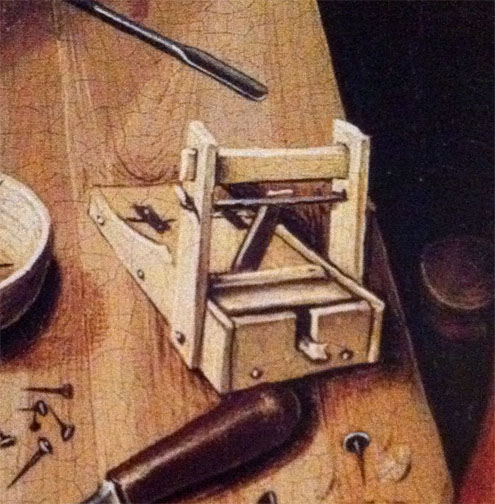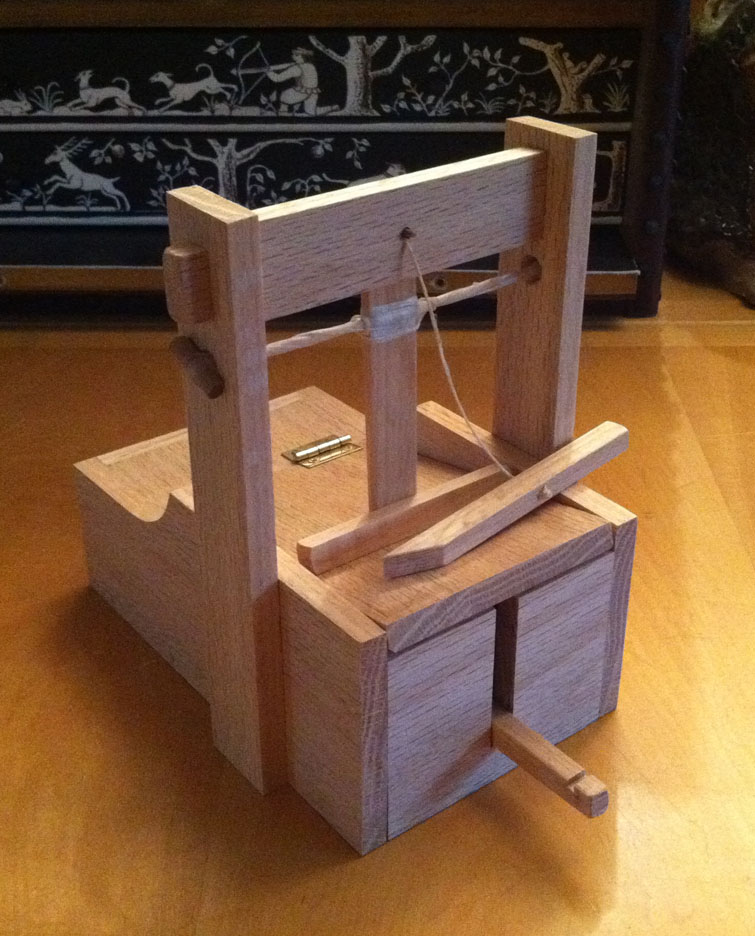The
Merode Triptych was painted in or around 1427 through a commission
which was likely received by Robert Campin, and then passed to an
unknown collaborator1.
Departing from a tradition of illustrating notable scenes from
the lives of Jesus and Mary, the third panel of this Triptych is
instead a detailed depiction of Joseph, working alone in his shop.
Amongst the tools and other items shown on his table is a
mousetrap, of the type described by Mascall in 1590 as a "following
trappe2." Although this item was once argued to be a carpenter's hand plane3,
the issue was resolved in 1966 by John Jacob, curator of the Walker Art
Gallery, Liverpool, when he commissioned a replica of the trap,
and used it to catch a mouse4.

Image from Web Gallery of Art
Although
the artist's representation of the trap is imperfect, as such things so
often are, it is nonetheless remarkable for its detail which allows key
features and functions to be identified. The basic form of the
trap is a box with a hinged lid. A torsion-sprung paddle, known
as a "follower5," is
positioned above the lid to drive it downward and to then hold it
closed. A trigger mechanism is hinted at by a square peg
extending from a slot near the base of the box. Rather than being
carefully joined, the box is simply nailed together as would be
appropriate for such a crude appliance, and as evidenced by the visible
nail heads and by the loose nails and hammer strewn about the table.
Hinges, mortised beam, and a conventionally pegged torsion
bundle, are all clearly shown. The paleness of the trap amongst
the darker table top and tool handles suggests that it is new or under
construction, and a second mousetrap displayed on the windowsill
confirms that these are indeed subjects of Joseph's handiwork.
What
the artist omits is any form of a trigger. When first observing
this painting, I incorrectly assumed that the trigger was therefore
internal, and that the square peg was an extension of a treadle which
must be manipulated to allow the trap to be "set." Being an
expert on modern trigger mechanisms6,
I envisioned a simple arrangement which accommodated these reasonable
assumptions. I have since come to learn that, although my
prospective design may have been superior to the trigger hastily
contrived by John Jacob for his earlier replica, I was no less
incorrect.
I had failed to notice at first that the
square treadle extension is apparently notched, or hooked, and I also
suffered under the unnecessary assumption that the trap, which after
all remained on the carpenter's worktable, was depicted as complete.
Further study led to the same conclusion which was generally
accepted in 1979 that the trap would have been fitted with an external
trigger of a type common to Medieval traps7, and described by Mascall as a "clicket8."
This device engages the notch in the treadle extension, and props
open the lid of the trap against the force exerted by the follower.
When the treadle is disturbed, the clicket is launched from this
position by the descending lid.
The Merode mousetrap was
expected to be non-lethal, as evidenced by the manner in which the
follower locks the closed lid against being opened from the inside.
This function also requires that the lid close completely, and so
precludes its use for crushing or impaling. Although the follower
does impart force to the lid to make it close faster, the result is not
particularly dangerous. I have sized this replica such that the
entire mouse, tail and all, should be safely inside when the lid drops.
Max
Written this seventh day of Aprill, 2011
1 DE VOS, D. 2002. "The Flemish Primitives." Princeton University.
2 MASCALL, L. 1590. "A booke of engines and traps to take polcats,
buzardes, rattes, mice and all other kindes of vermine and beasts
whatsoever, most profitable for all warriners, and such as delight in
this kinde of sport and pastime." John Wolfe, London. A facsimile
edition was published in 1973 by Theatrum Orbis Terrarum Ltd.,
Amsterdam and De Capo Press Inc., New York.
3 ZUPNICK, I. 1966. "The mystery of the Merode mousetrap." Burlington Magazine Vol. 108:126-133.
4 JACOB, J. 1966. The Merode mousetrap. Burlington Magazine 108:373-374.
5 MASCALL
6 I am. I totally am.
7 KLIJN, E.M.C.F. 1979. Ratten, muizen en mensen. Het Nederlands Openluchtmuseum, Arnhem.
8 MASCALL |


